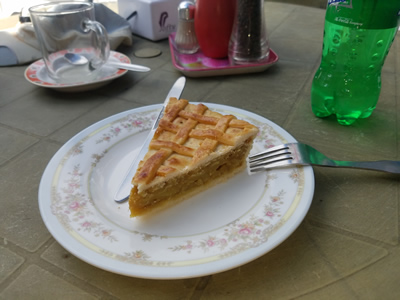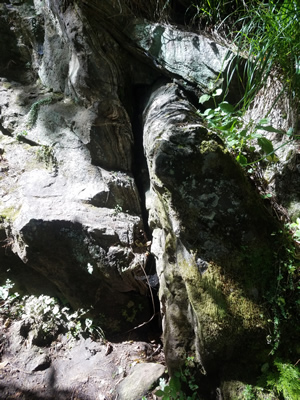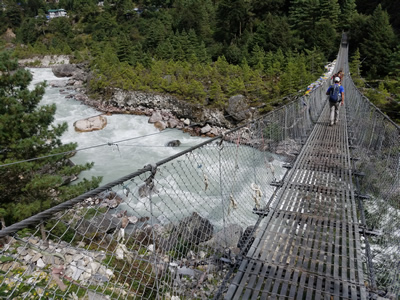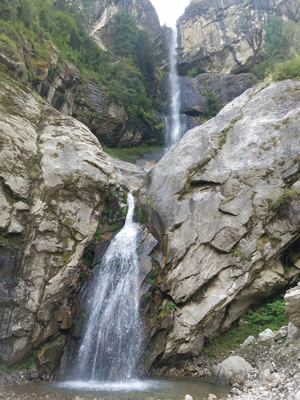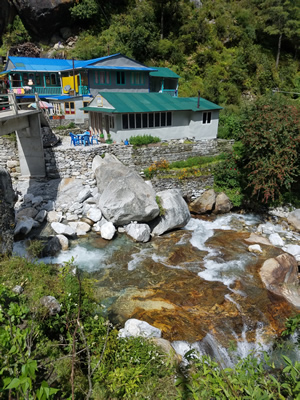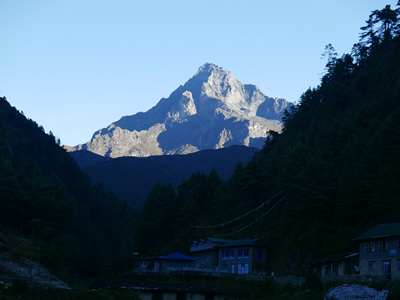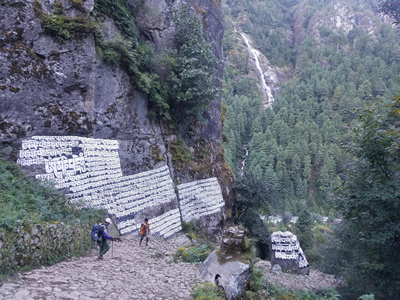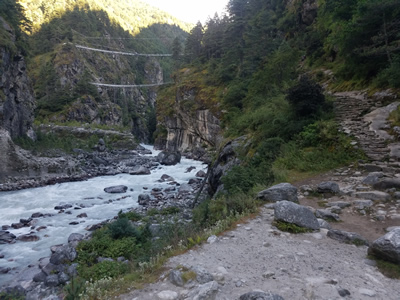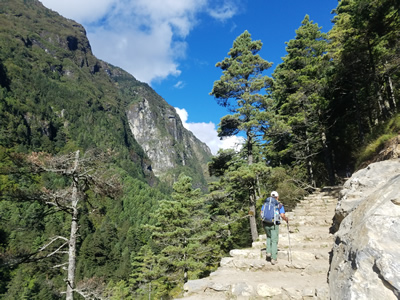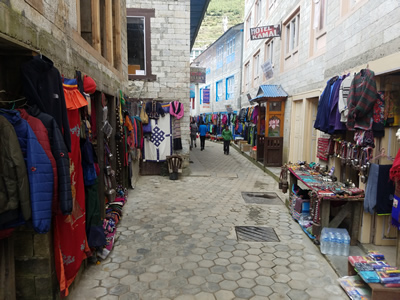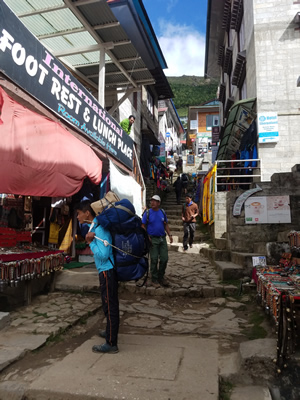Nepal Pt6: On To Namche
Per my last post, on day four of our trek we were back on track. We were finally where we should have been if we had been able to fly into Lukla. As it was we had a lot of adventures up to that point so even though we were behind schedule I don't begrudge the delay at all.
We stopped for lunch in the village of Phakding, where people usually spend their first night. The lady who ran the teahouse was Shambu's neighbor in Kathmandu. Nepali mountain people often live in more than one place, moving with the seasons. In the old days, during summer they would take their animals to high pastures to graze, while during winter they would come down to lower altitudes when it got too cold and snowy up high. Now many people live in the mountains in the spring and fall, during trekking season, where they work in the tourist business. In the summer and winter they go to the city, to Kathmandu, to find other work. When there are no trekkers, Shambu works as a taxi driver in Kathmandu.
While we were in Phakding I wanted to honor a tradition. On my first trip to Nepal we had been trekking in very remote areas for several weeks. Just like my current trek, we rejoined the standard Everest route near Phakding. It was our first stop "back in civilization", such as it was. My friends Brian and Mike and I celebrated with an impromptu party. We spent most of the afternoon in Phakding drinking beer and eating the only food that they had available, which was apple pie. On this trip, for old times sake, while we were in Phakding I made sure to order apple pie for lunch, although I did skip the beer.
Back in 1990 my friends and I had made fun of the fact that if you say the name Phakding really fast, it sounds like something else. So for a while, it was "that Phakding teahouse!" or "that Phakding apple pie!" or "this Phakding trek!". I told Shambu about it and asked if he got the joke. Puns are the toughest form of humor for a non-native speaker of a language. He said he understood so when lunch was over it was "time to get back on the Phakding trail again!".
Shambu had a little crude humor of his own. He told me that there was a local legend about two gods who were in love and had sex together in the woods near Phakding. Later in the afternoon he led me a short way off the trail and showed me where a long, thin rock was wedged in a crack in a cliff. According to the legend, it was supposed to graphically represent their tryst, captured in stone.
As creative as my imagination can be when it comes to such things, I had a hard time looking at the rocks and seeing anything erotic, even with my pareidolia turned up to max. You can look at the picture and judge for yourself. YMMV.
It was only midday so we kept hiking instead of spending the night in Phakding. Since we hadn't just flown in we had no need to stay to get used to the altitude here.
The hiking after lunch was pretty easy. It mostly followed the river, crossing over and then back again. The scenery was beautiful. Once we walked right by the base of a spectacular double waterfall. Later we came to the appropriately named Waterfall Rest House, a lodge just below a waterfall that tumbled into the Dudh Khosi. It had a patio overlooking both the river and the waterfall. It would have been a scenic place to stop if we hadn't already had lunch.
In one small village a helicopter came in for a landing just as we were walking through. Everyone stopped to watch, both people from the village and trekkers on the trail. Shambu talked to someone and found out that an old woman from the village was ill and was being evacutated to a hospital in Kathmandu. She was fortunate. That would be very expensive even in the US. Maybe she had good health insurance.
There was one short climb at the end of the day, up to the village of Monjo at 9320 feet, where we spent the night. The lodge there was nice. They had flush toilets and even a reasonable shower. Since this was our last day below 10,000 feet I didn't expect the weather to be warm and humid anymore. I decided it was a good opportunity to get cleaned up. Even Shambu took a shower here. That was unusual because Nepalis don't like to pay the extra money lodges charge to use the shower.
After dinner I was tired and was in bed and asleep by 7 pm. A few hours later when I woke up for a bathroom run I noticed flashing lights outside. The lodge/restaurant/bar across from us had christmas lights strung in the trees outside that were flashing on and off. It wasn't exactly like stayng on the Las Vegas Strip but it was quite a difference from my last trip to the Khumbu in 1990. Back then most of the villages didn't even have electricity. I guess this was progress.
Early to bed. Early to rise. The next morning we had breakfast and were on the trail by 6:45 am. The weather was clear and we had a great view of Khumbila, a beautiful rock peak that is 18,901 feet high. It looks like it would be very difficult. The mountain is said to be an ancient god. It's sacred to the Sherpas and so it has never been climbed. I was content to enjoy the view of it as I hiked up the valley.
Shortly after leaving Monjo we reached the entrance to Sagarmantha National Park. It's a UNESCO World Heritage site that contains Mt. Everest as well as two other 8000 meter peaks, Lhotse and Cho Oyu. There was a checkpoint at the entrance to the park so I waited while Shambu showed our permits to the police. Although it seemed like it should be pretty straightforward this process always took a long time and involved a lot of conversation. I have no idea what all the discussion was about but eventually we were cleared to pass through the gateway and into the park.
We started out with another easy section. The path stayed at the level of the river, once again crossing over to the other side and then later crossing back again. The hard work started when we reached the confluence of the Dudh Khosi with one of it's main tributaries, the Bhote Khosi. From here it would be 2000 feet of steady climbing to reach Namche. But first we had to cross the river one more time.
As we approached I could see a suspension bridge across the river and it was the highest one that we had encountered so far. It was a long bridge and had to be over a hundred feet above the river. It certainly looked like it would be quite exciting to cross.
Except that wasn't how we would get across. That was the old bridge and it is no longer in use. The new bridge, known as the Larja Dhoban Suspension Bridge, is even longer and looked to be at least twice as high up. It stretches 250 meters from the top of a cliff on one side of the river to the top of another cliff on the other side, a hundred meters above the river. This definitely looked like it was going to be an interesting crossing.
Just getting to the bridge was hard work. We had to climb up a long series of stone steps that switchbacked through the woods. When I finally reached the east end of the bridge I paused to catch my breath, standing at the top of a cliff, studying the narrow bridge that stretched over eight hundred feet across the chasm to the other side, three hundred and twenty eight feet above the river.
It wasn't really scary but I did take a deep breath before I started out behind Shambu. The crossing was definitely airy. I tried to walk lightly but the bridge bounced up and down under our steps. At the same time the bridge was swaying from side to side because of the wind. I had to hold onto the cables on the side to keep my balance as the bridge bucked and swayed under me.
It reminded me of a movie I had seen of the Tacoma Narrows Bridge. In 1940 a major bridge in Washington state collapsed because the wind triggered a resonant vibration that caused the road surface to bounce up and down violently. Eventually it shook the bridge apart. I think every college physics and engineering student is requied to watch that movie and I was no exception. I wasn't worried because I'm sure the guy who designed this bridge had seen it as well. I'm sure he provided enough flex and eliminated any resonances that would cause this bridge to suffer the same fate.
It did occur to me as I crossed that this would not be a good time for Nepal to have another earthquake like the one in April 2015. Since it had been two and a half years since that one I figured the next one probably wouldn't occur in the two minutes it took me to cross the bridge.
I was also pretty sure that the guy I saw the day before, who was terrified to cross a standard bridge, was really not going to like this one.
When I reached the other side safely, an old expression came to mind - "cheated death again". A friend of mine who was a flight instructor used to say that whenever he made a safe landing. This seemed like an appropriate time to use his saying.
After crossing the bridge it was just a steady uphill slog for a couple of hours to reach Namche. Half way up there was another police checkpoint. This time I had to pay 2000RS (about $20USD). I was kind of irritated because I thought I had paid all of my fees. I had paid for my trekking permit. I had paid the trekking company. I didn't understand why I had to pay again.
It didn't really matter though. It wasn't like I was going to turn around and go home. There was no sense in arguing either. The Nepalis were too good at it and besides, they thought it was good sport. As the old saying goes, "Never wrestle in the mud with a pig. The pig likes it". As it was, it took so long that eventually Shambu just told me to go ahead. I gave him the rupees and started walking again while he paid the fee.
When we reached Namche we went to our hotel and had lunch. Although it was only midday we were going to stay there for the night. At Namche we were at 11,290 feet. We were finally getting to the high country. Now how far we went each day was determined not by how long we could hike but by how much altitude we gained. To avoid altitude sickness we only went up about two thousand feet per day. In fact most trekkers who come in through Lukla spend an extra day in Namche to acclimatize. Since we had been trekking for many days we decided that we could continue after staying just a single night.
After lunch Shambu and I walked up to the Sagarmantha National Park Visitor Center. It's at the top of Chorkhung Hill, several hundred feet higher than our hotel. Unfortunately since it was a Saturday the building was closed. The view from the top of the hill, which on a clear day extends from Ama Dablam all the way to Mt. Everest, was obscured by afternoon clouds.
It wasn't a total waste of effort though. At least we got some extra acclimatization out of it. The best practice for adjusting to high altitude is to climb high during the day and then to descend to a lower altitude to sleep. We would be doing that for the next several days as we continued to go higher and higher.
On the way down we stopped at a restaurant that catered to Nepalis rather than foreigners. It was basically the kitchen in someone's house. There were several Nepalis there that Shambu said were all from his village and were working as porters for the season. None of them spoke English so I just nodded when he introduced me. I sat quietly for a half hour trying not to look dumb as they all chatted while they ate.
Although I only know a handful of Nepali words, I thought that the speech in the restaurant sounded very different than what I had been hearing. After we left I asked Shambu if they were speaking Tamang. He said that since they were from his village they were all Tamangs and had been using their local language.
Communication is actually a significant challenge in Nepal. In a county the size of the state of New York there are thirty million people who speak 123 different languages. And I complain that I can't understand people from Louisiana.
Next we went to check out the market. In Nepal, any town or village with a local market is called Bazaar. We were in Namche Bazaar and Saturday is market day. The park visitor center may have been closed but at least I would get to see the market. Except that when we went there after the restaurant people were just finishing packing up their stuff and leaving. We were too late. Man, I was really on a roll today.
After that we split up. Shambu did whatever he does when he isn't working while I spent the rest of the afternoon and evening looking around Namche. It had changed a lot since my previous visit twenty seven years ago, but this post is already long so I will save that for next time.
